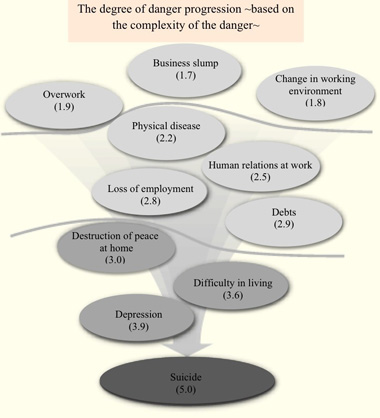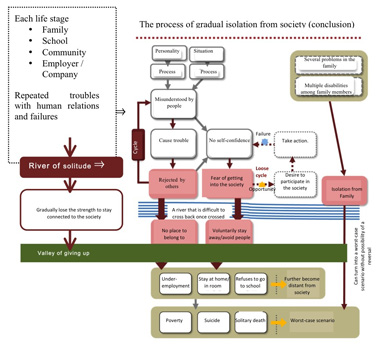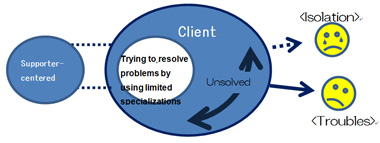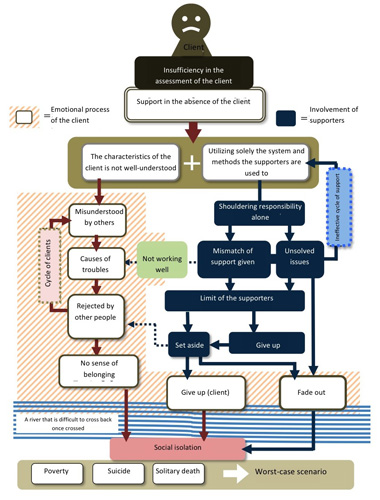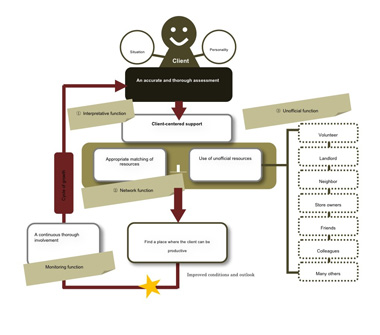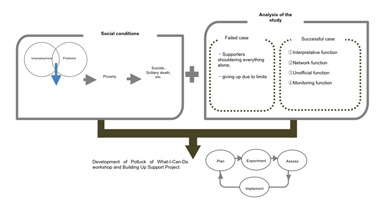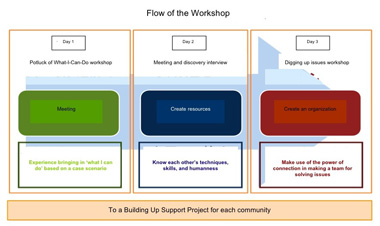A Report on “Potluck of What-I-Can-Do Workshop Manual” & “Building Up Support Project”
~ Concrete Steps towards an Interrelated and Supportive Community ~
Summary
I. Development of the Workshop
< Foreword >
This report is a summary of our efforts to implement the project to create and promote a cooperative network relative to social inclusion. It is one of the “2012 New Public Support for NPO’s Development Projects” that aims to promote the development of a cooperative network.
With the participation of the members of various supporting organizations (mainly NPOs) who are involved in social inclusion, we conducted several studies in order to develop the “Potluck of What-I-Can-Do Support” system. We further tackled the concrete alliance and cooperative network that would be formed from this point onwards. It is not an exaggeration to say then that this report was born from the place and time we shared with the participants of this project. We would like to take this opportunity to express my gratitude to everyone who participated in this project for their support and cooperation. Thank you very much.
We are living in a society which is now more functionalized and specialized than ever. The functionalization and specialization in itself were born out of the society’s needs. We benefit from this phenomenon through a wide array of high quality products and services. Our lives and lifestyles, on the other hand, are generalized and comprehensive, and accumulate daily in a holistic manner. This holistic entity, though, is about to be surpassed by the more specific functions and specializations; and, this is creating dents and bends in many aspects of the society.
Are we not in need of new knowledge and methods that could link the various functions and specializations? With that lingering question in our minds, we generated this report on how the “Potluck of What-I-Can-Do Workshop” and “Building Up Support Project” were created as a method of attaining the necessary links in order to achieve the common goal of creating a support system where each sector can bring in their respective services.
Creating a link between the various functions and specializations also created a link among the organizations and individuals involved. The supporting organizations and individuals not only possess their respective functions and specializations, but they also meet, connect, and support each other in a holistic life form...
We would be most delighted if this report can be utilized as a tool in achieving that goal.
March 2013
NPO Support Net for Small and Community Business - Kusanone Mutual Support Project Consortium
(1) The basis for the need of a workshop
In recent years, amidst what has become diversified and more complicated needs of the society, the community is facing an increased number of interrelated complex issues. NPOs (Non-Profit Organizations) have been working on solving these issues on a daily basis. However, each and every NPO cannot solve everything on its own. Thus, some problems are inevitably left unsolved.
To solve these complex issues, a networking system among the members of the local community has become essential. The members involved include the NPOs, the government, business sector, and local residents.
For a practical approach in creating such a network, our organization has been focusing on the issues of social poverty in our workshops. Having concrete hypothetical situations of “a person shouldering a problem alone,” the participants of the workshop create a process by involving the different sectors of the community, dividing the tasks, and obtaining a contribution from each sector to solve the individual’s problem.
We, therefore, would like to propose the “Potluck of What-I-Can-Do Workshop”as a method of forming a foundation, which will enable the different sectors of the community to contribute and make use of their respective strengths in finding solutions to complex issues.
(2) Social Conditions
In our society today, there is an increasing number of people living unstably in economic and emotional isolation due to their inability to find a comfortable place to live in and to obtain a role in the society.
According to a study conducted in January of 2012 (*1), there are more than 2,090,000 social welfare beneficiaries in the country, and the Relative Poverty Rate, which is an indicator of poverty of the citizens, has reached 16% (*2). Relative Poverty Rate in Japan is the proportion of citizens living with an annual income of less than or equal to ¥1,250,000. This means that 16 out of 100 citizens currently living in Japan have a monthly living expense budget of around ¥100,000.
Unemployment is one of the major causes of poverty. According to the Labor Force Survey conducted by the Ministry of Internal Affairs and Communications, the number of jobless citizens belonging to the 15 years old and above age group and with no source of income has increased to 47,860,000 in 2010. The magnitude of this figure becomes very obvious when compared with the total number of employed citizens, which is 62,570,000.
Among the jobless citizens are people known as the Solitary Non-Employed Persons (SNEP), who are characterized as being single, between 20 and 59 years of age, not enrolled in any academic institution, and who had not been with anyone besides family members for more than 2 consecutive days. In 2006, the number of SNEPs have surpassed 1,000,000, which showed an increase of 450,000 in the past 10 years (*3). Many of these SNEPs have not engaged in sports activities, travelled, joined in volunteer works, nor actively sought jobs for the past year. Furthermore, they live a solitary life and keep distance from the society in general. These citizens are responsible for the increase in the number of social welfare recipients belonging to the working age group.
Those citizens, who have fallen into isolation and poverty, have several problems at hand. These include problems at home, at work, having permanent disabilities, and difficulties in human relations. Suicide cases exceed 30,000 annually. According to asurvey (*4), those who committed suicide dealt with an average of 4 different root causes of difficulties before they took their own lives. The vicious process leading to suicide starts with poor performance at work or being laid off due to recession (a social problem), followed by having to deal with poor living conditions, carrying multiple debts, destruction of peace at home (a lifestyle problem), finally leading to sickness and mental illness (a problem of the individual). The transition to finally committing suicide has been found to be directly related to unemployment rate and social welfare benefit rate. As such, the suicide rate of social welfare recipients belonging to the working age group is more than twice the average rate (*5).
On the other hand, support system organizations including the likes of NPOs, have been dealing with such social problems according to their respective specializations. These fields of expertise include employment, mothers and children, young adults, homeless, foreigners, domestic violence, drug and alcohol addiction, and human rights advocacy. However, dealing with the complexity of the clients’needs, which goes beyond their realm of expertise, places them in a difficult position. They could not solve the clients’ problems alone, but the establishment of a collaboration and proper networking system among the organizations has not quite progressed yet. As a result, the basic support they provided for the lifestyle of clients who have multiple social problems remains vulnerable.
This country is described to have an aging population. In a few years, it is expected that one out of four citizens will be a senior citizen. The fact that this country will not be able to fully utilize the abilities of those citizens who had gone below the poverty line and had been isolated from the society, is a big loss not only for the individual involved, but also for the society as a whole. Japan does not have enough financial resources to provide a social security system that can be considered sufficient and reliable. The interrelationships among the members of the society should thus be strengthened to create a flexible and an inclusive society where everyone feels secure. There is now an urgent need to develop such a society where all the people can connect with one another and each person can play an active role in contributing to the community.
References:
*1 Welfare Policy Report (Approximate number in January 2012) (Ministry of Health, Labor, and Welfare)
*2 Overview of the Citizen’s Basic Lifestyle Survey, 2010 (Ministry of Health, Labor and Welfare)
*3 A Survey on the Solitary Non-Employed Persons (SNEP)
- Ministry of Internal Affairs and Communications (Social Lifestyle Basic Survey), analysis of anonymous data -
Yuji Genda (Institute of Social Science, Tokyo University), Kazuteru Takahashi (Doctor’s Course, Graduate School of Economics, Faculty of Economics, University of Tokyo)
*4 The Chain of Factors that Lead to Suicide (The NPO ‘Suicide Prevention and Support Centre – Lifelink’ “Survey of Suicide Cases of 1,000 Persons”)
*5 A Study on the Number of Suicide Cases among Social Welfare Recipients, 2010 (Ministry of Health, Labor and Welfare)
(3) Issues Found in the Pioneer Study
Considering the above-mentioned social conditions, we conducted a study of 140 cases of citizens who had been isolated from society. The problems of these citizens, who were unable to relate with anyone, were approached with the mindset of poverty being a problem of the society as whole, and not as the involved individual’s personal responsibility.
In the pioneer study, we examined the psychological process by which an individual reached a level of isolation and poverty. In the subsequent study, we examined an individual’s poverty and social isolation on a case-to-case basis, with the assumption that such situation may have possibly been a result of the failure in the supporters’ involvement. The success and failure stories of different organizations with various fields of specialization were consolidated through a series of hearings.
What became evident from the pioneer study was the fact that a socially weak individual, who holds various personal and situational problems, fail in many occasions to communicate effectively with other people, the society, and supporters. The individual then enters a cycle of feeling misunderstood → becoming alienated from others → losing self-confidence → developing a fear of society. With this vicious cycle, the individual loses trust and hope in the society and gradually loses connection with the community. Further isolation sets in until the worst case scenario of suicide or solitary death occurs.
This figure illustrates the process of gradual isolation from society. It describes how an individual goes into having repeated difficulties and failures with human relationships in each life stage such as family, school, community, and work place (company), and gradually loses interest to stay connected with society, thereby leading to isolation. Such a process is expressed as “crossing the river of solitude and going beyond the valley of giving up” and eventually ending in worst-case scenarios, such as poverty, suicide, and solitary death.
◊ Pattern: Failed Cases (Shouldering responsibility alone)
In contrast to the pioneer study, the secondary study used the cases of failure to analyze how the involvement of a supporter can affect the individual, and to determine what went wrong in the process. The patterns among the supporters’ failures were examined. What transpired from this study was a situation where the supporters (organizations and individuals) could not respond to the multiplicity and diversity of the problems of a socially weak individual with several social lifestyle problems all happening at the same time.
This figure shows a failed case (Shouldering responsibility alone). Please refer to the explanations above for details.
Support in the absence of the client him/herself leads to insufficiency in the assessment of the client and the system-oriented support. This figure shows how the process of having difficulties between the client and his supporters and giving up would lead the client to isolation. Please refer to the explanations above for details.
The NPOs and supporting organizations are desperately trying to support the concerned individuals through their various fields of specializations such as employment, mothers and children, young adults, homeless, foreigners, domestic violence, drug and alcohol addiction, and human rights advocacy. However, when the individual with multiple concerns brings up a problem beyond the realm of their expertise, only a few of these organizations will go the extra mile to extend support and to involve other support groups and communities. This then leads to a single support group solely shouldering the client’s problems alone and subsequently resulting in a support mismatch and unresolved issues. When the supporters reach the limit of their capabilities to help, they give up on the client’s problems and abandon them in the end.
◊ Pattern: Successful Cases (Network Type)
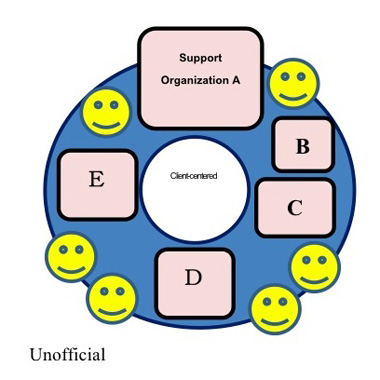 (Figure 5 text)
(Figure 5 text)
Successful Cases (Network Type)
On the other hand, in successful cases, an accurate, carefully conducted assessment is performed regularly. With the concerned individual as the subject person, many supporters and supporting organizations approach the client’s problems together as a team. Several supporting organizations initiate their group support by using a network, which tailors their services to the client’s concerns. An unofficial resource is, however, efficiently incorporated for problems that are beyond the competence of the organization and after having utilized and exhausted the resources of the existing system.
Those support systems that succeed in solving a client’s concerns involve a wide range of supporters and outsiders. The process involves (1) interpretative function, (2) network function, (3) unofficial function and (4) monitoring function, which unfold in chronological order. The study showed that the process they are implementing enabled the clients to find a place where they could peacefully live and play an active role in the community, thereby increasing the number of their supporters on their own, and finally creating an atmosphere that will keep them from isolation.
We thus call this supportive process the “Potluck of What-I-Can-Do Support” system, and made it the theme for the development of this workshop.
Here, an accurate and thorough assessment is conducted by paying attention to the client’s personal character and situation. This figure shows that, as a result of client-centered support, the client may be empowered to enter the cycle of growth.
Functions of client-centered support:
- Interpretative function: Supporters are poised between the client and the community for collaboration and mediation between the two.
- Network function: To address the client’s multiple difficulties with the help of people of various backgrounds, supporters get connected with various supporting organizations and individuals.
- Unofficial function: When the problems still remain unsolved after utilzing fully the competence of supporters and supporting organizations, support from people in the community is sought after.
- Monitoring function: When the client becomes produtive after having gone through the above three functions, the next step in providing support is by monitoring his growth.
(4) The Development Process of the Workshop
The Potluck of What-I-Can-Do Workshop was developed on the assumption that the “Network Support System” can be the ultimate solution to the challenges encountered in the past. These challenges were identified after thoroughly analyzing the aforementioned social conditions and the results of the study.
[Challenges] ~Social Conditions and Study Case Samples~ [cf. pp.2~6]
| ↓ | (1) Limit of the system (2) The boundaries of the support organizations and the resulting set of problems (3) Inadequate capabilities of the supporters (abilities, knowledge, initiative) |
[Ideal Form] ~Potluck of What-I-Can-Do Support System~ [cf. p.6]
This is a support system where the subject person is in the center of a process creating a condition where he/she will not be isolated.
◊ Elements Necessary for the Network, and Its Incorporation into the Workshop
| Elements Necessary for the Network | Elements Incorporated into the Workshop | |
|---|---|---|
| 1. | A network where the various capabilities of the supporters involved will be put to use and a mutual relationship based on trust will be established. | (a) To recognize the uneven distribution of social resources in the community. |
| (b) To experience the process of bringing in (like a potluck) the resources (what they can do) the supporters can offer. | ||
| 2. | A cross-over network that goes beyond the vertical boundaries between the different fields of specialization. | (a) To restructure the support system’s functions by going beyond the walls of their fields of specialization and placing the client’s problems at the center of the whole process. |
| (b) To further explore through mutual interviews the depth of available resources in the hands of the supporters. | ||
| 3. | A cooperative network which is self-sufficient and flexible enough to change in responding to various challenges. | (a) To visualize and discuss the issues of the community with its various members. |
| (b) A program where the supporters can SOS other participants about the subject person’s problem. |
The assumption was that a network that could address all the mentioned issues could become the ultimate solution to support the person caught in the contraints of the current system while having to deal with his/her problems. With this assumption in mind and the Potluck of What-I-Can-Do experience as a starting point, a series of planning, experimenting and assessing of the workshop development was done until a network useful for the community was established. After repeating this process and adding improvements along the way, the workshop was finally completed. Details of the workshop program will be shown on pp.10.
The development of “Potluck of What-I-Can-Do Workshop” and “Building Up Support Project” came about as a result of repeated analyses of social conditions causing isolation and poverty, and cases of failures and successes in the support of people in difficult situations.
(5) A summary of Potluck of What-I-Can-Do Workshop and Building Up Support Project
The “Potluck of What-I-Can-Do Workshop” is a workshop that will help the involved sectors, such as supporters, NPOs, government administration and companies, in realizing the existence of a vertical barrier among them and in trying to make a horizontal connection instead. There have been cases of clients with multiple problems that were set aside and were given up in the past. In this workshop, we (1) share the possibilities of what can be done by connecting the different sectors and (2) reassess and identify any insufficient function and skills within the network. In doing so, we pursue ways of developing the community in order to share the experience and the process of transforming “what can’t be helped…” into “there might be something we can do!” for the subject person. This workshop can be introduced into each community to establish the “Building Up Support Project” (a network useful in the community) with the aim of resolving the issues and difficulties of people in personal crisis.
| ◊ Day 1 | ◊ Day 2 | ◊ Day 3 |
| Potluck of What-I-Can-Do Workshop | Encounter and Discovery Interview | Workshop on Uncovering the Issues |
| A kick-off case study of a person with multiple concerns (cf. pp. 81~86) is used to bring out comprehensive ideas from the participants. They then have a first-hand experience of exhausting their resources and realizing their limits. This is followed by a realization that a problem, which is impossible to solve alone, can be resolved through a cooperative effort among the participants from various sectors. | With “residence,” “place of belonging,” “employment,” and “communication” as a starting point, the participants go beyond the vertical boundary of their fields of specialization to make a potluck of what they can do. These ideas will be laid out on a map to unveil which members of the community can do what functions and how they can carry out such functions. | Representatives of NPOs, government administration, companies and the core group of the community each bring up the issues and difficult cases they encounter in the real setting, and discuss them as a group. They then form a Project Team to implement what they learned within the four walls of the workshop into actual field work. |
The “Building Up Support Project” introduced to each community with the aim of solving the issues and difficulties encountered.

